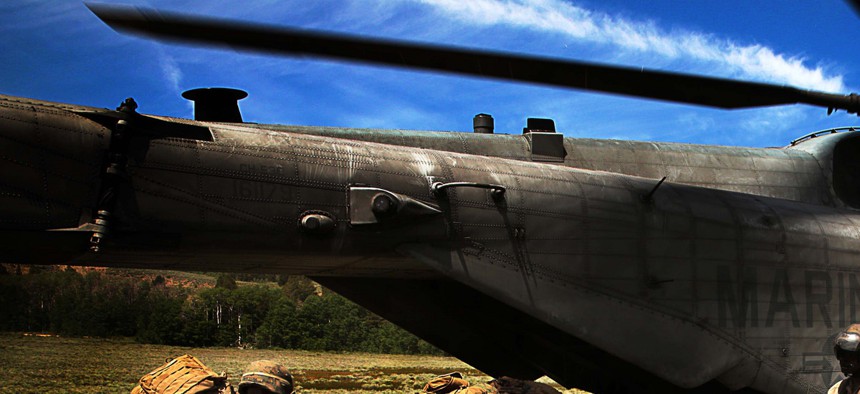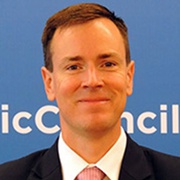
Marines with the 5th Marine Regiment board a CH-53 helicopter for extraction after multiple patrols in the Mountain Warfare Training Center's training area, on June 21, 2014. U.S. Marine Corps photo by Cpl. Charles Santamaria
What Fallows Missed About the Military-Civilian Gap
Why there is a gap between the military and America is as important as how it occurs. By Mark Seip
In The Atlantic article “The Tragedy of the American Military,” James Fallows discusses how the present disconnect between the military and civilian sectors manifests itself either in popular culture or in policy decision-making. While the how of the issue is important, Fallows neglected to take the time to fully explore why this schism exists. It is necessary to understand what the root causes of the disconnect are if senior leaders are to bridge this gap.
First, there is an emotional disconnect, as Fallows alludes. While he primarily focuses on why civilians don’t connect with troops, he neglected to articulate what drives the emotional divide from those in service. From the military side, many of us feel that we are unique to our generation in our calling; that we rose above the self-absorbed stereotype often associated with both Gen Xers and Millennials to protect our nation. We accept significant time away from our families, often subpar working conditions compared to our civilian counterparts, and average pay in relation to the skills we possess in order to wear the uniform. Moreover, as our nation’s warrior corps we assume a level of risk since time immemorial, that our occupation entails a distinct possibility of loss of life. Our service therefore requires a level of confidence and self-assurance to do our jobs and take the risks required.
However, this mentality can easily lead to pride and arrogance in relation to those who choose not to or are unable to serve, and a distrust of decisions made by civilian leadership who have not faced those same risks.
Second, the widening gap is a function of exposure, both in numbers and in proximity. As Fallows points out, 2.5 million served in either Iraq or Afghanistan. To provide context, according to an NPR study 8.7 million served in some capacity in Vietnam. Furthermore, during Vietnam the majority of the generation at that time had fathers and mothers who served in some capacity either in WWII, Korea or both. Today, however, the actual number and/or the tangential family tie to the military is lower, reinforcing the distance between those in service and the rest of the nation.
Military bases within the United States are trending towards two extremes. The first are those that are isolated, due to either the need for access to large training spaces (for example NAS Lemoore and its strike fighters in central California) or that the national security mission requires it (Minot AFB and its nuclear arsenal in North Dakota), inhibiting a broader interaction. The second trend is towards consolidated basing regions. With the drive for greater efficiencies through the base realignment and closure process, more military personnel are being relocated into specific locations such as Norfolk for the Navy and San Antonio for the Air Force, creating cities of like-minded active duty or retired military. Add to all of this what retired Lt. Gen. David Barno calls the “gated community” mentality of bases themselves, with housing, household shopping and recreational activities located on or near the various facilities. As a result, military and nonmilitary personnel have fewer chances to interact and understand one another.
So how is this relationship repaired? A solution commonly offered, especially since the later years of the Iraq War, is to institute a draft. In 2013 Rep. Charles Rangel, D-N.Y., introduced the “Universal National Service Act” which would make national service compulsory for 18 to 25-year olds for two years. He wrote at the time, “I sincerely believe that reinstating the draft would compel the American public to have a stake in the wars we fight as a nation.” Moreover, the idea of national service requirements has its admirers within the current military itself. As one example, it is not uncommon to find among the military an affinity for the book Starship Troopers, and indeed it appeared on all five service reading lists at one time. While most elements of the book are innocuous, the premise that often resonates is that all should serve, and that in order to vote and be a full citizen one must serve in the military. Even Joint Chiefs Chairman Gen. Martin Dempsey in 2012 called for “universal service” of mandatory military service for all Americans, but not the Selective Service or a military draft.
While a draft sounds like an appealing option, the simple fact is that this idea of compulsory service goes against the very foundation of the republic and its emphasis on individual rights and individual choices. Moreover, as many Vietnam-era leaders will attest, to compel individuals to take part in something against their desire, especially something as severe as military service, will likely create as many problems as it solves. Therefore, with the exception of an existential threat to the country itself every citizen should have the right to choose whether or not to serve.
As for geography, the management of the military is viewed primarily through a fiscal lens. Neither senior military or civilian leaders are going to increase the size of the Armed Forces or reverse basing decisions simply to create stronger ties between the two groups. But the Pentagon for third year in a row is expected to ask Congress for a new round of Base Realignment and Closure, or BRAC, to cut costs. There should be more informed discussions about the impact that these decisions will make on the military-civilian divide, this time around.
As for the emotional disconnect, both sides need to do their homework. Fallows alludes to the need on the civilian side for less hero worshiping and a more sophisticated understanding and greater scrutiny of the military. While I would agree, that also implies that said scrutiny comes with an understanding of the military, either through service itself or through engagement and informed study. Most Americans this month will get their modern military education from Hollywood, as the film “American Sniper” opens nationwide on Friday, one day after being nominated for Best Picture. In reality however, this is less of an education and more of an entertainment piece using the military as its vehicle and like most military movies should be treated with caution. Rather, as one example of informed study, Professor Richard Kohn of University of North Carolina recently remarked that military studies classes at universities are in high demand; this demand signal should be met by university leadership. While fewer civilian leaders have been on the receiving end of military-based decisions, having an appreciation for the human cost will go a long way towards demonstrating respect for the work of the military.
In turn, the military would do well to reeducate itself on its role in the larger context of national power. It is an instrument of a democratic system and all the imperfections that system creates, requiring patience and a holistic view. For officers, that education should not be done once as a midshipman or cadet or only for those few who attend a service college, but should be reemphasized at different points throughout the careers of all. Additionally, the force should refocus on the less dramatic but no less important values that comprise service. Humility, others before self, and commitment to those we serve – and the civilian leadership of our democracy – are just three examples of attributes that must be emphasized at regular intervals through all ranks within the force.
The disconnect is real but not irreversible. A greater understanding of how decreased exposure is shaping the cultural dynamic can create a more informed decision-making process, while a renewed focus on the nuances of each side and the values that underpin service will create a better understanding and bridge the gap between the military and those it serves.




